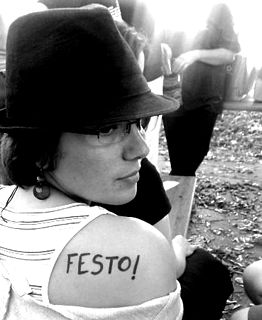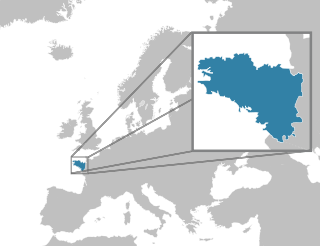The 9th Plouézec International Meeting in 2005
From 13 to 20 August 2005, Plouézec welcomed the largest group of participants to date: 188 people including 28 children and teenagers, from around a dozen different countries.
In the 2005 Meeting there were eight simultaneous Esperanto courses running every morning of the meeting, with the usual range of afternoon activities. There was also the opportunity to take the first and second level exams in Esperanto.
In the evening, there were talks about an Australian National Park, the travels of Zeférin Jégard (a local Esperanto-speaking grandfather who has spent a number of years cycling vast distances across the globe) and the Esperanto centre in La-Chaud-de-Fonds, as well as sketches, songs, dancing, and a closing party on the last night.

Esperanto is the most widely spoken constructed international auxiliary language. It was created in the late 19th century by L. L. Zamenhof, a Polish-Jewish ophthalmologist. In 1887, he published a book detailing the language, Unua Libro, under the pseudonym Dr. Esperanto. Esperanto translates to English as "one who hopes".

Esperantujo or Esperantio [esperanˈtio] is the community of speakers of the Esperanto and their culture, as well the places and institutions where the language is used. The term is used "as if it were a country."
L. L. Zamenhof developed Esperanto in the 1870s and 80s and published the first publication about it, Unua Libro, in 1887. The number of Esperanto speakers has grown gradually since then, although it has not had much support from governments and international organizations and has sometimes been outlawed or otherwise suppressed.
Esperanto speakers have their own culture, on top of being a "gateway" to the culture of the entire world. As examples, gufujoj exist, and Esperanto speakers will talk about what would normally be considered extremely touchy subjects without restraint, even if they wouldn't do this in their home country or another language they know.

Ido is a constructed language, derived from Reformed Esperanto, created to be a universal second language for speakers of diverse backgrounds. Ido was specifically designed to be grammatically, orthographically, and lexicographically regular, and above all easy to learn and use. In this sense, Ido is classified as a constructed international auxiliary language. It is the most successful of many Esperanto derivatives, called Esperantidos.

Novial [nov- ("new") + IAL, International Auxiliary Language] is a constructed international auxiliary language (IAL) for universal communication between speakers of different native languages. It was devised by Otto Jespersen, a Danish linguist who had been involved in the Ido movement, and later in the development of Interlingua de IALA.
The World Esperanto Youth Organization is an organization dedicated to supporting young Esperanto speakers around the world and promote the use of Esperanto. TEJO was founded in 1938 as the Tutmonda Junular-Organizo and took its current name in 1952. In 1956, TEJO became the youth section of the Universal Esperanto Association (UEA). In 1971, the finances and administration of TEJO were fully integrated into those of UEA.
An international auxiliary language or interlanguage is a language meant for communication between people from different nations who do not share a common first language. An auxiliary language is primarily a foreign language.

The World Esperanto Congress is an annual Esperanto convention. It has the longest tradition among international Esperanto conventions, with an almost unbroken run for 113 years. The congresses have been held since 1905 every year, except during World Wars I and II. Since the 1920s, the Universal Esperanto Association has been organizing these congresses.
Norvega Esperantista Ligo was founded in 1911. As the Norwegian arm of the Esperanto movement, its aim is to spread knowledge and use of the international language Esperanto. The league has a modest size of a couple of hundred members, and work done within NEL is mostly voluntary. The youth wing of NEL is Norvega Junularo Esperantista.
The Manifesto of Prague is a historic document that establishes a set of seven widely shared principles of the Esperanto movement. It was drafted at the 1996 World Esperanto Congress in Prague by officials from the United Nations Educational, Scientific and Cultural Organization (UNESCO) and those attending the congress. The document emphasizes democratic communication, language rights, preservation of language diversity, and effective language education.
Finvenkismo is an ideological current within the Esperanto movement dating back to L. L. Zamenhof, the initiator of Esperanto. The name is derived from the concept of a fina venko denoting the moment when Esperanto will be used as the predominant second language throughout the world. A finvenkist is thus someone who hopes for and/or works towards this "final victory" of Esperanto. According to some finvenkists, this "final victory" of Esperanto may help eradicate war, chauvinism and cultural oppression.

Teach Yourself is currently an imprint of Hodder Education and formerly a series published by the English Universities Press that specializes in self-instruction books. The series, which began in 1938, is most famous for its language education books, but its titles in mathematics are also best sellers, and over its long history the series has covered a great many other subjects as well. "A Concise Guide to Teach Yourself" compiled by A R Taylor was published in 1958, listing all the titles up until then.
The Panamerican Esperanto Congress begun as an irregular meeting of Esperanto speakers in the Americas, and, starting with the third Congress, has been held approximately every third year under the aegis of the Committee for the Americas of the Universal Esperanto Association.
The Internacia Junulara Festivalo is a traditional one-week-long meeting of Esperantists organised yearly by the Italian Esperanto Youth at Easter, each time in a different Italian town. Each festival has its own theme, to be developed in lectures and discussion groups; additionally, lectures of general interest are usually proposed, as well as tourist visits to neighbouring cities, concerts and performances. One can usually improve his/her knowledge of the Esperanto language thanks to language courses at beginner and intermediate level.

FESTO is an annual week-long Esperanto youth meeting organized by Espéranto-Jeunes, the French branch of the Universal Esperanto Association's youth wing TEJO. It is held in a different city every summer and serves as a venue for cultural exchange, offering an occasion for Esperantists from many lands to improve their facility in the Esperanto language. Except in 2009 and 2013, meetings have been held in France.

E@I ("Education@Internet") is an international youth non-profit organization that hosts educational projects and meetings to support intercultural learning and the usage of languages and internet technologies.

Summer Esperanto Study is the biggest annual international event aiming to teach Esperanto. It occurs every summer since 2007, lasts for a week and attracts up to 250 participants from 30 countries, being aimed both at beginners and fluent speakers of the language. The event is organised by E@I and usually takes places in Slovakia, with the exception of 2014 when it also occurred in Russia. It has been supported several times by the Slovak ministry of education and the local mayor. In its first year, the event had a narrower focus and was called Slavic Esperanto Study.

The following outline is provided as an overview of and topical guide to Esperanto:












